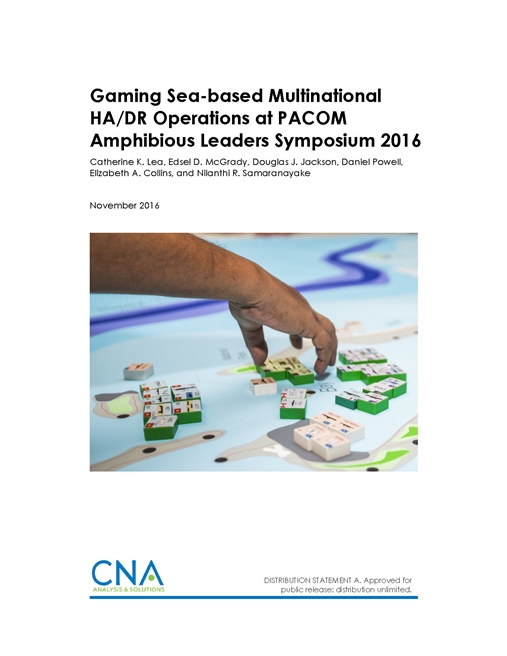The PACOM Amphibious Leaders Symposium (PALS) annually brings together senior naval leaders of Pacific allied and partner navies and marine corps to strengthen relationships among them and improve mutual understanding. Military leaders from 22 Asian, Latin American, and NATO countries participated in PALS 16. U.S. Marine Corps Forces Pacific (MARFORPAC), acting as PACOM’s executive agent, asked CNA to design and conduct a table-top exercise (TTX) for PALS 16 that would explore seabasing operations and interoperability during future regional contingency operations. This paper provides an overview of that TTX, “Operation Shattered Jewel,” which took place on 12 July 2016 in San Diego, California.
TTX objectives
As part of the overall PALS agenda, the TTX provided participating allied and partner nations with an opportunity to discuss cooperative and coordinated actions. The purpose of these discussions was to create a shared understanding of each other’s abilities to conduct sea-based operations in support of a crisis ashore. During PALS, participants also discussed their experiences in previous HA/DR operations and they observed a live U.S. seabasing demonstration. The TTX served to conceptually bridge participants’ past HA/DR experiences to emerging seabasing concepts and technologies. Within this context, the TTX had four objectives:
- Discuss seabasing in the context of a disaster where operations must be sea based.
- Develop a shared understanding of how sea-based disaster relief operations might occur.
- Identify and discuss sea-based interoperability issues and how the sea base would execute a disaster relief operation.
- Provide a venue for collaboration, relationship building, and knowledge sharing.
Scenario
The CNA team created a scenario in which a massive natural disaster strikes a fictitious country in the southern Indian Ocean. Using a fictitious country ensured that military forces contributing to the HA/DR operation would not be bound in their response decisions by their governments’ relationships with and policies toward a specific country. Players could simply make choices and allocate their forces based on the dictates of the operational situation.
The scenario began with a 9.2-magnitude earthquake striking in the Indian Ocean directly off the coast of the Republic of Topaz. Three hours later, a 7.5-magnitude aftershock produced a major displacement of water, which came ashore as a tsunami. As a result, most of Topaz lay in ruins. Complicating matters, its neighboring country, the Kingdom of Ruby, has a territorial dispute over Topaz’s southern islands, collectively known as the Southern Development Area (SDA), where Ruby actively supports an insurgency. Due to its geography, Ruby was not affected by the earthquake and tsunami.
At the beginning of the TTX, the estimate was that some 2 million inhabitants of Topaz were in need of immediate support in terms of food, clean water, medical assets, and other relief supplies. However, the nearly complete destruction of key ports, airfields, and other transportation infrastructure within the archipelago hampered large-scale relief operations. Ruby demanded that it be allowed to conduct relief operations in the SDA, which Topaz refused. In response, Ruby closed its ports and airfields to relief operations. The Government of Topaz (GOT) established a temporary government center at an air base and military reserve station on a minimally damaged island. The GOT restricted the airfield to military and civil defense use.
Download reportDISTRIBUTION STATEMENT A. Approved for public release: distribution unlimited.
Details
- Pages: 50
- Document Number: DRM-2016-U-014109-Final2
- Publication Date: 11/29/2016
